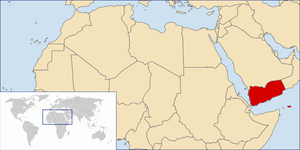
- Image via Wikipedia
I took part in a “qat chew” the other day at the home of a Yemeni official. Never done that before. Qat is the mildly hallucinogenic leaf drug that Yemeni men stuff in their cheek after work — and sometimes during. My hosts insisted that qat actually makes your senses sharper and that you could chew and chisel the top of a mosque minaret at the same time. I quit after 15 minutes, but the Yemeni officials, lawmakers and businessmen I was with chewed on for three hours — and they made a lot of sense along the way.
Most had been educated in America or had kids studying there, and they were all bemoaning how the decline of the Yemeni education system, the proliferation of exclusively religious schools here and the falloff in scholarships for Yemeni kids to study in America were producing a very different Yemeni generation than their own. They spoke fondly of U.S. schools that were based on merit, taught them to think freely and prepared them with the skills to thrive.
So here is my new rule of thumb: For every Predator missile we fire at an Al Qaeda target here, we should help Yemen build 50 new modern schools that teach science and math and critical thinking — to boys and girls.
If we stick to something close to that ratio of targeted killings to targeted kindergartens, we have a chance to prevent Yemen from becoming an Al Qaeda breeding ground. Because right now there are some 300,000 college-educated Yemenis out of work — partly because of poor training and partly because there are no jobs — 15,000 schoolchildren not attending any classes, 65 percent of teachers with only high school degrees and thousands of kids learning little more than religious doctrines.
And no wonder. Beginning in the 1970s, the trend in Yemen, Morocco, Egypt and the Persian Gulf “was to Islamicize education as a way to fight the left and pro-communists — with the blessing of the U.S.,” explained Lahcen Haddad, a professor at the University of Rabat in Morocco and an expert on governance with Management Systems International, a U.S. development contractor. Then, in 1979, after the Saudi ruling family was shaken by an attack in Mecca from its own Wahabi fundamentalists, the Saudi regime, to fend off the anger of its Wahabis, “gave them free rein to Islamicize education and social life in Saudi Arabia and neighboring states.”
“Missions — cultural and religious, semi-official and private — roamed Islamic countries to spread the word,” said Haddad. “Cheap books followed, and students were brought to Saudi to learn from Wahabi preachers and teachers in the different religious universities that mushroomed in the ’80s.”
Small, economically deprived Yemen was an easy target. Uncritically accepting of the “truths” of Wahabism became the core curriculum in many Yemeni schools, Haddad added, and “it destroyed the opportunity to build the basic skills necessary to train the right labor force — skills like problem-solving, communication, critical thinking, debate, organization and teamwork.”









